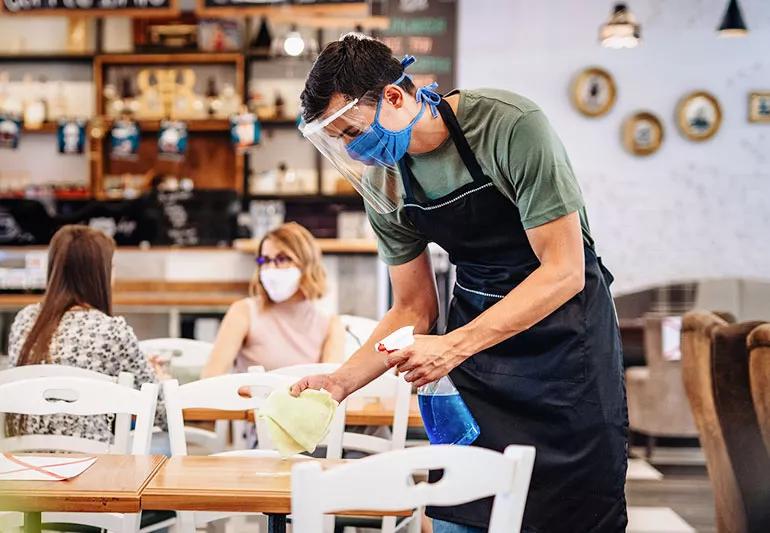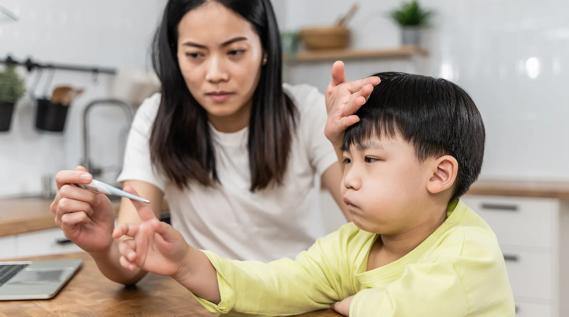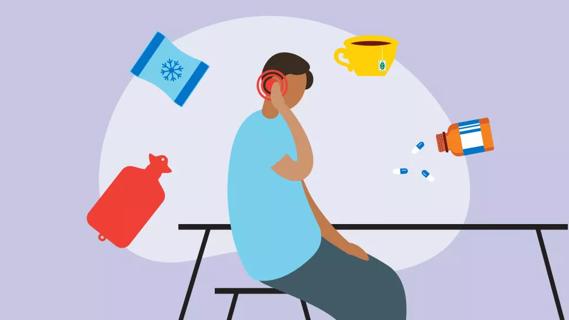Advertisement
And learn how to stay safe while you're indoors or waiting in lines

The cold winter months are closing in fast. Soon, many of us will have to readjust once again and learn how to navigate through the time of the year when we’re stuck inside. And since we’re at the intersection of cold and flu season and a pandemic, being forced inside could mean the possibility of coming in close contact with someone who was exposed to COVID-19.
Advertisement
Cleveland Clinic is a non-profit academic medical center. Advertising on our site helps support our mission. We do not endorse non-Cleveland Clinic products or services. Policy
Recently, the CDC updated its definition of “close contact” to the following.
“Someone who was within six feet of an infected person for a cumulative total of 15 minutes or more over a 24-hour period starting from two days before illness onset (or, for asymptomatic patients, two days prior to test specimen collection) until the time the patient is isolated.”
Given the number of superspreader events reported within the past few weeks, people have taken notice of the 15 minute exposure period mentioned in the definition. And because of it, people have started referring to the definition as the “15-Minute Rule.” But should we live our lives by this rule and as we move indoors, how can we protect ourselves? Keep reading to find out what pulmonary and critical care physician Joseph Khabbaza, MD, recommends doing to stay safe.
Fifteen minutes is often used as a timeframe in contact tracing investigations. For example, a recent Morbidity and Mortality Weekly Report from the CDC explains how a correctional officer in Vermont contracted COVID-19 after multiple short interactions with six incarcerated or detained persons (IDPs). The IDPs weren’t showing symptoms at the time, however, they were tested and the results were pending. The correctional officer was around this group of IDPs on July 28. On August 4, he experienced a loss of smell and taste, muscle pain, runny nose, cough, shortness of breath, headache, loss of appetite, and gastrointestinal symptoms.
It’s worth noting that in this case, the officer maintained his distance and reported that he had not come into close contact with anyone who had COVID-19 in the 14 days before he became ill. Also, the IDPs weren’t wearing masks. The officer did report wearing personal protective equipment (cloth mask, goggles and a gown) for the most part, but the CDC stated that some interactions were missed during their investigation.
Advertisement
In the end, the investigation found that while the officer didn’t spend 15 consecutive minutes with the IDPs, all of the times that he interacted with them came close to that time (17 minutes to be exact).
According to Dr. Khabbaza, there are a lot of variables that factor into this “rule.” It’s not a deal where you can say, “I was around my friends for less than 15 minutes. There’s no way that I could have been exposed to the coronavirus.” It doesn’t work that way.
“It’s not a black and white thing where you reach 15 minutes and you’re likely infected or when it’s less than 15 minutes, you’re not. There are a lot of gray areas — a lot of factors and variables that come into play. If during those 15 minutes, someone is unmasked and sitting next to another unmasked person at the library, and they’re both reading, writing or doing work without speaking, that is a very different 15 minutes than if they’re doing droplet generating things like talking and laughing. So, not all 15 minutes are the same,” says Dr. Khabbaza.
Earlier on in the pandemic, we worried about becoming infected while shopping or getting take-out. Dr. Khabbaza says mask mandates have helped reduce the risks of that. But again, if you’re not physical distancing, washing and sanitizing your hands frequently or wearing a mask, you are putting yourself at risk — even if you are out in public for a few minutes here and there.
Dr. Khabbaza says that there isn’t any hard evidence that compares the coronavirus 15-minute rule with other respiratory viruses. He says that sustained contact with respiratory viruses, like COVID-19, is needed for infection. But measles are much different.
Dr. Khabbaza explains.
“Measles, for example, is a more contagious respiratory virus. It’s one that’s associated with airborne transmission, or it can kind of float for a bit in the air even if the infected person is no longer around. With the common cold and flu, sustained contact is required to get either one.”
With the flu and COVID-19, it’s clear that the precautions that have been put in place have made a difference in slowing the spread of both. Dr. Khabbaza says this is very evident in the Southern Hemisphere.
“Right now, the Southern Hemisphere is kind of between the middle and tail end of their flu season. And they’re hardly seeing any influenza compared to last year. This further shows that social distancing and masking decrease the transmission of contagious respiratory infections. They’re particularly seeing this with parents and kids. Parents tend to get illnesses that their kids have. But it seems like a lot of parents have been healthier and their kids haven’t been getting as sick as they have in years past, especially since they’re not in school,” Dr. Khabbaza says.
Advertisement
As temperatures drop, heated patios and tents might be out of the equation for many of us. Some of us might even feel the urge to entertain inside more. But should we?
“Any gathering, whether it’s inside or outside, with unmasked people who are outside of your smaller circle — where you don’t know where they’ve been or how they live — is going to be higher risk. We know of spreading events that occur outdoors when people are in close contact and unmasked. And certainly, all the risks are going to be heightened indoors because virus particles are unable to disperse quickly like they do when they reach the air. So really any social gathering with people outside of your smaller circle is going to carry the risk of transmission. This is why we have to be very, very careful about the types of gatherings we have this fall and winter,” says Dr. Khabbaza,
If you plan to have people over, Dr. Khabbaza suggests wearing masks inside to reduce the risk of infection should there be people on the guest list who are wildcards when it comes to wearing masks or people who are high risk.
Many essential workers are required to enter a lot of different homes throughout the day. If your job calls for you to do so, Dr. Khabbaza recommends wearing a face shield in addition to your mask to protect yourself. “Infected droplets getting into the eyes is another way that you can get COVID-19. If your eyes are covered, even if somebody is unmasked around you and talking, the droplets they’re producing can’t go through that shield. So really think of a face shield as an extra layer of protection.”
Advertisement
Dr. Khabbaza says it’s possible to get COVID-19 while standing in a line, but only if people aren’t wearing masks, standing six feet apart or if they’re in a place with poor ventilation. “If you’re distanced and wearing masks, it’s going to be very hard to get the virus if somebody is infected in line, especially if you’re outdoors.”
Many grocery stores, gas stations and post offices require face coverings and have floor markings that indicate where to stand while waiting in line. Those measures alone help reduce the chance of transmission. But Dr. Khabbaza recommends a few other things that you can do to be safe.
If you know you’re going to have to swipe your credit card and approve your purchases, keep hand sanitizer on you. That way, you can clean your hands after every transaction. But if you don’t have hand sanitizer, Dr. Khabbaza says that as long as you’re not touching your eyes, nose or mouth, you won’t transmit whatever is on your hands to yourself.
If you find yourself around people who aren’t wearing masks while standing in line, avoid having lengthy conversations with them. Talking, laughing or even yelling can produce more droplets. So keep exchanges polite, yet brief. And if you end up next to someone who is extra chatty, you can always let them know that you’d feel more comfortable not talking to protect yourself and those around you.
Advertisement
We know we need to maintain physical distance, but this can be much harder to do inside. Dr. Khabbaza recommends getting a feel for lines before you get in one. Look how everyone is standing and if they’re not spaced out, you can stand further back if it makes you feel more comfortable. But if you know you’re going to a place that doesn’t have a lot of room, mask up and wear a face shield to be safe.
Dr. Khabbaza emphasizes that while the pandemic has created a lot of concerns, things can still be done safely right now.
“There’s no need to lock yourself at home — even if you’re high risk. If you’re nervous about the possibility of being around unmasked people, then you want to avoid settings that might put you in that situation. At the end of the day, keeping the risk as close to zero as possible is critical — because our strongest weapon against COVID-19 is avoiding it.”
Learn more about our editorial process.
Advertisement

A COVID-19 infection can bring on depression or anxiety months after physical symptoms go away

Just like the flu, COVID-19 continues to evolve every year with new and smarter variants

The latest omicron subvariants carry specific mutations that may allow the SARS-CoV-2 virus to be better at evading immune protection

Research shows the virus can affect your ability to get or maintain an erection

RSV can lead your child to develop pneumonia and have trouble breathing

Getting vaccinated in October can help protect you against severe illness between November and March

Respiratory syncytial virus spreads easily through respiratory droplets spewed out by those who are infected

Face-touching is a common habit, but one that can be overcome, like by learning to recognize when you’re doing it and keeping your hands distracted

Not all ear infections need antibiotics — cold and warm compresses and changing up your sleep position can help

A glass of lemon water in the morning can help with digestion and boost vitamin C levels, and may even help get you into a better routine